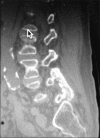Preliminary study showing safety/efficacy of nanoss bioactive versus vitoss as bone graft expanders for lumbar noninstrumented fusions
- PMID: 26167369
- PMCID: PMC4496830
- DOI: 10.4103/2152-7806.159380
Preliminary study showing safety/efficacy of nanoss bioactive versus vitoss as bone graft expanders for lumbar noninstrumented fusions
Abstract
Background: The lateral fusion mass for multilevel lumbar laminectomies with noninstrumented posterolateral fusions now often utilizes lamina autograft and bone marrow aspirate (BMA) mixed with one of two bone graft expanders: either Vitoss (Orthovita, Malvern, PA, USA) or NanOss Bioactive (Regeneration Technologies Corporation: RTI, Alachua, FL, USA).
Methods: Here, we compared two sequential prospective the times to fusion, fusion rates, complications, and infection rates for two prospective cohorts of patients utilizing either Vitoss (first 213 patients) or NanOss (subsequent 45 patients) respectively, undergoing multilevel lumbar laminectomies (average 4.6 vs. 4.5 levels) with noninstrumented fusions (average 1.3 vs. 1.2 levels). Surgery addressed stenosis/ossification of the yellow ligament (OYL) (all patients), with subsets exhibiting degenerative spondylolisthesis synovial cysts, and disc disease. Fusion was documented by two independent neuroradiologists blinded to the study design, utilizing dynamic X-rays and two dimensional computed tomography (2D-CT) studies up to 6 months postoperatively, and up to 1 year where indicated.
Results: Comparison of patients receiving Vitoss versus NanOss as bone graft expanders revealed nearly comparable; times to fusion (5.3 months vs. 4.8 months), fusion rates (210 [98.6%] vs. 45 [100%] patients), pseudarthroses (3 [1.4%] vs. 0), postoperative seromas (2 [0.94%] vs. 0), and deep wound infections (2 [0.94%] vs. 0).
Conclusion: In this preliminary study of patients undergoing multilevel lumbar lamienctomies with posterolateral noninstrumented fusions, results were nearly comparable utilizing Vitoss or NanOss as bone graft expanders. Although the number of NanOss patients was substantially lower, the comparable efficacy and absence of postoperative complications for noninstrumented fusions is promising.
Keywords: Autograft; Beta-TriCalcium phosphate; NanOss Bioactive; Vitoss; noninstrumented lumbar fusion; pseudarthrosis rates.
Figures




Similar articles
-
High lumbar noninstrumented fusion rates using lamina autograft and Nanoss/bone marrow aspirate.Surg Neurol Int. 2017 Jul 20;8:153. doi: 10.4103/sni.sni_248_17. eCollection 2017. Surg Neurol Int. 2017. PMID: 28808602 Free PMC article.
-
Preliminary documentation of the comparable efficacy of vitoss versus NanOss bioactive as bone graft expanders for posterior cervical fusion.Surg Neurol Int. 2015 May 7;6(Suppl 4):S164-71. doi: 10.4103/2152-7806.156559. eCollection 2015. Surg Neurol Int. 2015. PMID: 26005578 Free PMC article.
-
An analysis of noninstrumented posterolateral lumbar fusions performed in predominantly geriatric patients using lamina autograft and beta tricalcium phosphate.Spine J. 2008 Nov-Dec;8(6):882-7. doi: 10.1016/j.spinee.2007.11.005. Epub 2008 Feb 14. Spine J. 2008. PMID: 18280215 Clinical Trial.
-
Efficacy of different bone volume expanders for augmenting lumbar fusions.Surg Neurol. 2008 Jan;69(1):16-9; discussion 19. doi: 10.1016/j.surneu.2007.03.021. Surg Neurol. 2008. PMID: 18054607 Review.
-
Allograft Versus Demineralized Bone Matrix in Instrumented and Noninstrumented Lumbar Fusion: A Systematic Review.Global Spine J. 2018 Jun;8(4):396-412. doi: 10.1177/2192568217735342. Epub 2017 Oct 25. Global Spine J. 2018. PMID: 29977726 Free PMC article. Review.
Cited by
-
Synthetic Bone Graft Materials in Spine Fusion: Current Evidence and Future Trends.Int J Spine Surg. 2021 Apr;15(s1):104-112. doi: 10.14444/8058. Epub 2021 Apr 21. Int J Spine Surg. 2021. PMID: 34376499 Free PMC article.
-
Use of Autologous Stem Cells in Lumbar Spinal Fusion: A Systematic Review of Current Clinical Evidence.Global Spine J. 2021 Oct;11(8):1281-1298. doi: 10.1177/2192568220973190. Epub 2020 Nov 18. Global Spine J. 2021. PMID: 33203241 Free PMC article.
-
High posterior cervical fusion rates with iliac autograft and Nanoss/bone marrow aspirate.Surg Neurol Int. 2017 Jul 20;8:152. doi: 10.4103/sni.sni_241_17. eCollection 2017. Surg Neurol Int. 2017. PMID: 28808601 Free PMC article.
-
High lumbar noninstrumented fusion rates using lamina autograft and Nanoss/bone marrow aspirate.Surg Neurol Int. 2017 Jul 20;8:153. doi: 10.4103/sni.sni_248_17. eCollection 2017. Surg Neurol Int. 2017. PMID: 28808602 Free PMC article.
-
Novel Nanomaterials for Developing Bone Scaffolds and Tissue Regeneration.Nanomaterials (Basel). 2025 Aug 5;15(15):1198. doi: 10.3390/nano15151198. Nanomaterials (Basel). 2025. PMID: 40801736 Free PMC article. Review.
References
-
- Epstein NE. A preliminary study of the efficacy of Beta Tricalcium Phosphate as a bone expander for instrumented posterolateral lumbar fusions. J Spinal Disord Tech. 2006;19:424–9. - PubMed
-
- Epstein NE. An analysis of noninstrumented posterolateral lumbar fusions performed in predominantly geriatric patients using lamina autograft and beta tricalcium phosphate. Spine J. 2008;8:882–7. - PubMed
-
- Epstein NE. Beta tricalcium phosphate: Observation of use in 100 posterolateral lumbar instrumented fusions. Spine J. 2009;9:630–8. - PubMed
-
- Kaiser MG, Groff MW, Watters WC, 3rd, Ghogawala Z, Mummaneni PV, Dailey AT, et al. Guideline update for the performance of fusion procedures for degenerative disease of the lumbar spine. Part 16: Bone graft extenders and substitutes as an adjunct for lumbar fusion. J Neurosurg Spine. 2014;21:106–32. - PubMed
LinkOut - more resources
Full Text Sources
Other Literature Sources

